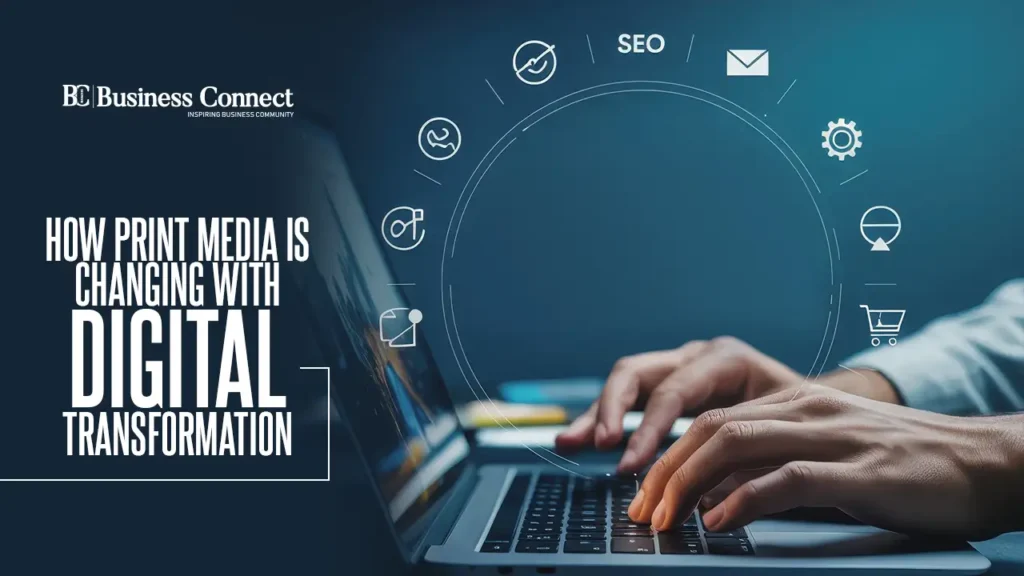How Print Media Is changing with Digital Transformation
-by Jaya Pathak
Print isn’t leaving the stage; it’s changing the script. The strongest news and magazine brands now treat print as a premium, limited‑run product—carefully edited, visually interactive, and built for unhurried reading—while digital delivers rolling coverage, multimedia experiences, and community engagement. That clear split reduces internal friction, sharpens editorial choices, and strengthens the combined economics of print and digital.
The strategic pivot begins with product architecture. Print editions increasingly emphasize long‑form features, reported analysis, visual essays, and evergreen service journalism that reward time and attention. Digital surfaces handle breaking stories, explainers, newsletters, podcasts, video, live blogs, and interactive graphics. A modular content workflow— “create once, tailor everywhere”—allows one reporting effort to travel across page, web, app, audio, and social with channel‑specific headlines, layouts, and runtimes. Research products, rankings, and courses further extend lifetime value.
Companies are not dependent upon a single source of income. They are focusing on adding multiple revenue streams. Subscription plans are now coming in a range of levels. It can be used to encourage users to upgrade for a higher value experience. There are some readers who still prefer print edition instead of the digital ones. Subscription can be provided to those readers combining both digital and print. For brand building, print ads matter a lot. Digital advertising has its own pros. But success is measured through quality engagement and alignment with reader interest, not just by number of page clicks.
Operations have modernized to support quality at speed. Cloud content systems, shared taxonomies, and cross‑functional desks (editorial, product, design, data, audio/video) enable predictable production while preserving editorial judgment. Print runs are leaner and smarter: optimized formats reduce trim waste; regional editions cut logistics cost; short‑run and print‑on‑demand models support special issues tied to major investigations, lists, or conferences. Continuous testing—on headlines, visual hierarchy, and calls‑to‑action—improves conversion and retention without diluting standards.
Audience development is now a habit business. Morning and evening briefings, topic digests, and restrained mobile alerts build predictable touchpoints. Registration walls collect first‑party data with clear consent, enabling relevant recommendations and lifecycle messaging. Moderated comments, Q&As, member forums, and virtual town halls convert passive readers into participants. For younger cohorts, short video and concise explainers serve as discovery; the owned app or site remains the destination for depth, credibility, and archives.
Print continues to anchor brand stature. A cover story still sets an agenda, providing a focal point for campaigns, events, and sponsorships. Niche and professional titles perform well when they deliver authority, craft, and tightly defined communities—areas where the tactile qualities of print remain a differentiator. Many publishers now synchronize marquee print issues with award programs, summits, or proprietary research, turning editorial peaks into integrated commercial moments.
Sustainability has moved from messaging to method. Publishers are changing to recycled or certified papers, water‑ or soy‑based inks, right‑sized formats, and consolidated transport. On the digital side, optimizing images and video, managing data footprints, and tuning infrastructure reduce energy intensity. These choices lower cost, mitigate supply risks, and reinforce credibility with readers and advertisers who evaluate operational footprints alongside content.
People and culture determine the pace of change. Newsrooms are investing in data visualization, audience research, product management, and audio/video alongside reporting. Editors commission with multiple surfaces in mind, and standards teams update guidance for evolving formats. Training emphasizes verification at speed, accessibility, inclusive sourcing, and creator safety in public digital spaces. Clear governance—conflict protocols, transparent corrections, and disciplined labeling—safeguards trust in an algorithmic distribution environment.
The most durable strategies share three traits. First, a crisp value proposition that articulates why the brand merits time and payment. Second, visible craftsmanship—clean navigation, typographic care, disciplined editing—that saves readers time and rewards attention. Third, measurement guided by judgment: data informs packaging and cadence but does not dictate agendas. Done well, digital transformation does not dilute print; it restores the value of editorial choice and extends that value through new channels, formats, and revenue lines.
FAQs
- Why does print still matter in a digital‑first operation?
Print confers permanence and authority, supports reflective reading, and functions as a brand flagship that powers events, sponsorships, and digital amplification.
- How are publishers reducing dependence on advertising?
They are building blended models: tiered subscriptions and premium bundles, enterprise licenses, branded content, events and research products, and targeted commerce aligned to audience needs.
- What operational changes enable true cross‑platform publishing?
Modular content systems, shared taxonomies, cloud workflows, and cross‑functional teams let one reporting effort become tailored outputs for print, web, apps, newsletters, audio, and video.
- How do publishers engage younger audiences without eroding loyalty?
Short video and explainers drive discovery; newsletters, apps, and member communities build habit and depth; clear standards and moderation preserve trust.
- Is sustainability materially changing print and digital operations?
Yes. Responsible paper and ink choices, optimized formats, and smarter logistics reduce print impact, while efficient media delivery lowers digital energy use—improving costs and strengthening brand credibility.



